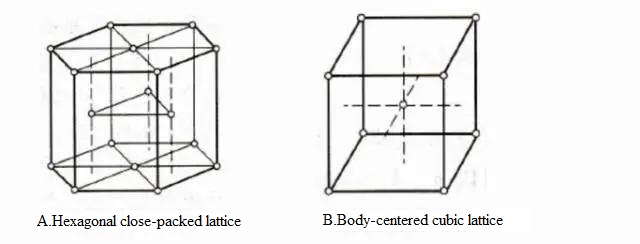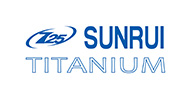Some basic fact about Titanium and Titanium Alloys
Time:2022/01/17 Pageviews:1 Share:
 Titanium is a metal element with the chemical abbreviation Ti, atomic number 22, which has a silvery-white metallic luster in appearance. The density of titanium is 4.51g/cm3 and the melting point is 1668℃.
Titanium is a metal element with the chemical abbreviation Ti, atomic number 22, which has a silvery-white metallic luster in appearance. The density of titanium is 4.51g/cm3 and the melting point is 1668℃.Titanium has two isomers. The α-Ti is stable below temperature of 882 °C and has a hexagonal close-packed lattice (hcp) structure; the β-Ti exists stably between 882 °C and the melting point 1668℃, which has a body-centered cubic lattice ( bbc) structure.
Titanium is widely distributed in nature, accounting for about 6‰ of the mass of the earth's crust. It is the ninth most abundant element and the seventh in the metal family. There are more than 70 kind of titanium minerals and the more common ones are ilmenite (Fe-TiO3), rutile (TiO2) and vanadium-titanium magnetite. The content of titanium in seawater is 1 μg/L, and a large amount of titanium is also contained in seafloor nodules. In addition to this, titanium can also be found in meteorites, coal ashes, plants, and even in human body.
Titanium products
There are two main types of titanium products: the first is sponge titanium, which can be further processed to prepare various titanium materials. The second is titanium dioxide, which is a white pigment, widely used in coatings, paints and other items in the chemical industries.
After the titanium concentrate is smelted into sponge titanium, it can be made into industrial pure titanium and titanium alloy through ingot casting.
Titanium product characteristics
Industrial pure titanium and titanium alloys have the characteristics of corrosion resistance, high temperature resistance and high strength-to-weight ratio. Titanium alloys have more diverse properties and wider applications than industrial pure titanium due to the addition of other alloying elements.
Corrosion resistance
Titanium and titanium alloys have good corrosion resistance in different media and different temperature conditions. In particular, the corrosion resistance in seawater is better than that of aluminum alloys, stainless steels and nickel-based alloys. It estimated that a piece of titanium material submerged in seawater for 4000 years it would only have corrosion to the depth of about the thickness of a piece of printer paper.
The corrosion resistance of titanium comes from passivation. In the atmosphere or aqueous solution, a well-protected oxide film (passivation film) is immediately formed on the titanium surface. This oxide film has very good healing properties, and can be self-repaired quickly (less than 0.1s) to form a new film after being mechanically damaged. When the temperature is below 315℃, the oxide film of titanium can always maintains this characteristic.
High temperature resistance
Industrial pure titanium and titanium alloys can maintain good strength and performance in high temperature environments. Pure titanium is slightly lower and can function stably below 350 °C; the working temperature of titanium alloys can reach 500 °C or higher.
High strength-to-weight ratio
The strength-to-weight ratio of industrial pure titanium and titanium alloys are both very high. Strength-to-weight ratio refers to the ratio of the strength to the density of a material. High strength-to-weight ratio means that the material is strong and also light in weight. Such properties are very popular in the aerospace field.
Commonly used materials for aircraft or spacecraft include stainless steel, nickel-based alloys, and aluminum alloys. Compared with stainless steel and nickel-based alloys, titanium alloys have almost half the density and lighter weight; compared with aluminum alloys, which can only work below 200 °C, titanium alloys are more resistant to high temperatures therefore the advantages are significant.
Industrial pure titanium
Industrial pure titanium (purity of 99.5%) is essentially a titanium alloy with low alloy content, containing nitrogen, carbon and impurity elements such as iron and silicon. Its annealed structure is α structure. Because it contains more impurity elements, its strength is higher than that of chemically pure titanium (purity is as high as 99.9%, also known as high-purity titanium), which is close to that of high-strength aluminum alloys, but its strength is still lower than that of titanium alloys.
The mechanical and chemical properties of industrial pure titanium are similar to those of stainless steel. It is primarily used for stamping parts and corrosion-resistant structural parts whose working temperature is below 350 ℃, and the force is not exceptionally large but requires high plasticity.
In China, the industrial pure titanium is divided into four grades: TA1, TA2, TA3 and TA4 (GR1, GR2, GR3, GR4 in ASTM) according to its impurity content. The interstitial impurity elements of the four types of industrial pure titanium gradually increase, so their mechanical strength and hardness also increased, but their plasticity and toughness decreases accordingly. Industrial pure titanium commonly used in industry is TA2, because of its moderate corrosion resistance and comprehensive mechanical properties. TA3 can be used when higher requirements on wear resistance and strength are required. TA1 can be used when better molding properties are required.
Titanium alloy
Titanium alloys are alloys in which other elements are added based on titanium. The alloying elements added are Al, Mo, Cr, Sn, Mn, V, etc.
Hundreds of titanium alloys have been developed in the world, among which the most famous Ti-6Al-4V alloy successfully developed in the United States in 1954, due to its ideal heat resistance, strength, plasticity, toughness, formability, weldability, corrosion resistance and biocompatibility, it has become the trump card alloy in the titanium alloy industry. The use of this alloy has accounted for 75% to 85% of all titanium alloys. Many other titanium alloys can be seen as modifications of the Ti-6Al-4V alloy.
The specific gravity, strength and service temperature of titanium alloy are between aluminum and steel, but higher than both of them in strength-to-weight ratio, and have excellent seawater corrosion resistance and ideal performance in the ultra-low temperature. Titanium alloys are widely used as important structural materials in the aerospace industry.
Titanium alloy classification
Titanium alloys can be divided into three categories according to the annealed structure: α titanium alloys, β titanium alloys, α+β titanium alloys (also including near-α alloys containing a small amount of β alloy). The code name of α titanium alloy is TA, the code name of β titanium alloy is TB, and the code name of α+β titanium alloy is TC. Among the three, titanium alloy α and α+β are more commonly used. The titanium alloy α has good machinability, followed by α+β titanium alloy, and β titanium alloy is poor in machinability.
Titanium alloys can also be divided into heat-resistant alloys, high-strength alloys, corrosion-resistant alloys (titanium-molybdenum, titanium-palladium alloys, etc.), low-temperature alloys and special functional alloys (titanium-iron hydrogen storage materials and titanium-nickel memory alloys) according to their applications.
Grade and use:
Alpha α titanium alloy
Performance:
Low strength at room temperature, high strength at high temperature; good oxidation resistance, corrosion resistance and weldability; it cannot be strengthened by heat treatment, used in annealed state.
Grade:
In China, TA4, TA5, TA6, TA7, TA8, etc. TA5 and TA7 are commonly used, with TA7 (GR6 in ASTM) being the most commonly used. TA7 also has good low temperature performance.
Application:
It can be used below 500℃, such as the low temperature-high pressure container of rocket ship, blade and pipeline of aero-engine, missile fuel cylinder, etc. TA5 is mainly used to manufacture ship parts.
Beta β titanium alloy
Performance:
It can be strengthened by heat treatment, has high strength, good welding performance and pressure processing performance; but the performance is not stable enough, and the smelting process is complicated, so it is not as widely used as α-type and α+β-type titanium alloys.
Grade:
There are TB1, TB2 and TB3, and the actual application is TB2. TB2 alloys are generally delivered in a solution treated state and used after solution.
Application:
It can work below 350°C, such as compressor blades, wheel discs, shafts and other heavy-load rotating parts, as well as aircraft components.
The α+β titanium alloy
Performance:
It has the advantages of both α-type and β-type, most of which can be strengthened by heat treatment, but the welding performance is not as good as α-type.
Grade:
TC1~TC11, most commonly used are TC3, TC4, TC6, TC9 and TC10. TC4 is equivalent to Ti-6Al-4V, which is the most commonly used. TC10 is developed on the basis of TC4 and has higher strength and heat resistance.
Application:
Aero-engine compressor blades working below 400°C, rocket engine casings, missile liquid hydrogen fuel tank components, and ship pressure-resistant casings.


 Chinese
Chinese English
English


